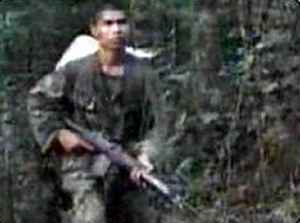| "The Singapore government
asked Philippine authorities to search for al-Ghozi in December, and immigration
records led to his arrest in Manila on December 17.
Al-Ghozi is a member of the
Jemaah Islamiya terrorist cell, the group the Singapore government said
was plotting to bomb the U.S. Embassy and other interests.
While under interrogation,
al-Ghozi told police about three men in General Santos City, in the southern
Philippines, who were linked to the Moro Islamic Liberation Front (MILF),
the largest Muslim separatist group in the Philippines. Authorities found
and arrested the three Filipinos, all of them brothers.
The arrest of those men --
Mohammad Malagat, Almuctar Malagat, and Mualidin Malagat -- led police
to one ton of explosives and detonating devices that police say were intended
for targets in southeast Asia.
Philippine police said they
are looking for two other Indonesians as part of the same investigation.
When pressed for details, police said they were broadening the net in their
effort to fight terrorism in the Philippines.
The link between the MILF
and the al Qaeda network could mean changes for the government's relationship
with the separatist group, which is currently involved in peace talks with
Manila.
SOURCE
Fighting in the jungles of
Basilan
U.S. troops encounter
tough terrain on front lines of terror war in Philippines
BASE CAMP, Basilan Island,
Philippines, Jan. 17 — Afghanistan was bad enough with its harsh,
mountainous landscape. But the terrain at the latest front line in the
U.S. war on terror is difficult in a different way: The dense, tropical,
hilly jungles on Basilan Island in the Philippines are nearly impenetrable.
Here, U.S. Special Forces are training Philippine army personnel in an
effort to help them track down the Abu Sayyaf, an Islamic militant group
believed to have links to al-Qaida.
IN AFGHANISTAN, the foe was
hidden away in craggy mountains and sheltered by a vast cave complex. In
the southern Philippines, the jungle provides a dense shield for
those seeking refuge.
“Visibility in the jungle
is 10 feet or less,” said Brig. Gen. Gliserio Sua, who is in charge of
operations in the southern Philippines. “Once, there were four or five
of the guerillas hiding just 5 feet away. But we were not able to notice
them.”
For government forces, sniper
fire is a real threat. The government says about 50 soldiers and more than
150 guerrillas have been killed in brutal, close combat since June, when
5,000 Filipino troops mounted a campaign to rescue hostages.
The guerrillas are holding
Martin and Garcia Burnham, missionaries from Wichita, Kan., who were kidnapped
in May along with a Filipina nurse, Deborah Yap. Of the 18 other hostages
taken since then, eight have been released for ransom and 10 beheaded.
The Philippine army has set
up three forward bases on this island. One of them has a rough helipad
where the Army’s four helicopters in the region drop off troops and materials.
It’s a long, hard trek through ravines and hilly jungles from the helipad
to the central forward base, itself nothing but a clearing in the forest
where about 100 men have pitched tents. There is not even a perimeter fence
to guard against a guerrilla attack.
NO ENGAGEMENT
But Sua said that guerrilla
attacks on the camp are not the problem. “The problem is the Abu Sayyaf
are continually trying to evade us,” he said. “If they had been cooperative
enough to engage with us, then we could have solved the problem a long
time ago.”
That means, of course, that
army patrols have to go out into the jungles in search of the guerrillas,
a quest that has been largely fruitless.
U.S. officials worry that
al-Qaida members who are on the run could seek refuge in Basilan.
“The Abu Sayyaf are out there,”
said Lt. Clark Dalumbar, who’s been at the central forward base for a while
now, “but we cannot pinpoint where exactly they are” because of a lack
of intelligence and technology.
The soldiers in Basilan don’t
need anything as heavy-duty as the so-called “daisy cutters” — massive
bombs used in the campaign at Tora Bora, Afghanistan. They’re expecting
high-tech gear for stealthy on-the-ground operations: Night vision goggles,
heat-detecting devices and survey lens equipment.
Filipino intelligence sources
believe that Abu Sayyaf was financed in the early 1990s through Mindanao-based
Muslim charities run by Mohammad Jamal Khalifa, a Saudi and brother-in-law
of Osama bin Laden. Khalifa is believed to have maintained links with Abdul
Hakim Murad, a bin Laden operative arrested in the Philippines in 1995
in connection with an attempt to kill Pope John Paul II during a visit
to Manila and a plot to bomb 12 U.S. airliners. Murad’s roommate in Manila
was Ramzi Yousef, an al-Qaida operative who was convicted of helping plan
the 1993 bombing of the World Trade Center. Yousef is believed to have
trained with Janjalani in Afghanistan.

|
